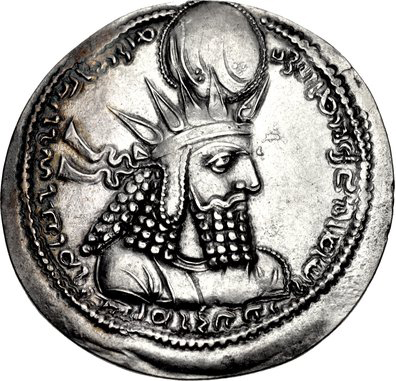The article below by Shapour Shahbazi on Sassanian king Bahrām I (c. June 271 – September 274 CE) was originally published in the Encyclopedia Iranica on December 15, 1988 and last updated on August 24, 2011.
Kindly note that picture posted below does not appear in the original publication and on-line posting by Encyclopedia Iranica.
==================================================================
Bahrām I, the fourth Sasanian king and son of Šāpūr I, succeeded Hormozd (Ohrmezd) I and ruled from June, 271 until September, 274 (for the chronology of the early Sasanians, the findings of W. B. Henning, Asia Major, 1957, p. 116, are followed here). Four of Šāpūr’s sons are named in his Kaʿba-ye Zardošt inscription (A. Maricq, Classica et Orientalia, Paris, 1965, pp. 61-62): Bahrām Gēlān Šāh, Šāpūr Mēšān Šāh (King of Mesene), Hormozd (Ohrmezd) Ardašīr, Wuzurg Šāh ī Arminān (Great King of Armenia), and Narseh Sakān Šāh (King of the Sakas, exceptionally honored later in the inscription, Maricq, ibid., p. 58, as “the noble Mazdā-worshipping Narseh, King of Sind, Sakastān, and Tūrān to the edge of the sea”). The order shows that Bahrām was the eldest son (Henning, “Notes on the Great Inscription of Šāpūr I,” in Professor Jackson Memorial Volume, Bombay, 1954, p. 419 n. 6), and indeed, the prince is shown on the Naqš-e Rajab investiture relief of Ardašīr I, facing his name-deity Bahrām, who is figured in the Hellenistic guise of Herakles, nude and club in hand (W. Hinz, Altiranische Funde und Forschungen, Berlin, 1969, p. 124 with pl. 59). However, despite Bahrām’s age and Narseh’s exalted position, the succession of Šāpūr had been decided in favor of Hormozd Ardašīr, who, however, reigned for only just over a year. Then Bahrām ascended the throne, probably with the help of the influential priest, Kardēr. Narseh probably looked upon Bahrām as a usurper (see bahrām, iii), but had to settle for the second rank in the empire, becoming “Great King of Armenia” (V. Lukonin, “Varakhran i Narse,” in VDI 1, 1964, pp. 48ff.; H. Humbach and P. O. Skjærvø, The Sassanian Inscription of Paikuli III/1, Wiesbaden, 1983. pp. 66ff.).
Sassanian coin of Bahram I (c. June 271 – September 274 CE) (Source: Public Domain).
Bahrām was fond of fighting, hunting, and feasting, which he regarded as virtues (Henning, “Mani’s Last Journey,” BSOS 10, 1942, p. 951), and Sasanian-based sources praised him as a benevolent and worthy king. This was no doubt partly due to his reversal of Šāpūr’s policy of religious tolerance, which enabled the clergy led by Kardēr to proceed with the establishment of a Zoroastrian state church. In 274, he ordered the imprisonment and subsequent execution of Mani, and the persecution of his followers (Henning, ibid., pp. 949ff.). Otherwise Bahrām’s short reign was uneventful. His coins show him wearing the characteristic crown of Mithra: a headgear adorned with ray-shaped spikes (K. Erdmann, “Die Entwicklung der sasanidischen Krone,” Ars Islamica 15-16, 1951, p. 96; R. Göbl, Sasanian Numismatics, Brunswick, 1971, p. 43, pl. 3 nos. 40-47). The lost Book of the Portraits of Sasanian Kings (Ḥamza, p. 50) depicted Bahrām I as standing, holding a lance in the right hand and leaning upon a sword held in the left, and wearing red gown and trousers and a gold crown topped with a sky-blue globe (Erdmann, op. cit., p. 96 n. 3). Following Ardašīr and Šāpūr, Bahrām I symbolized his accession in a rock-relief (Bīšāpūr IV) showing him on horseback, receiving the diadem of royalty from Ohrmezd, also shown mounted. The relief is accompanied by a Mid. Pers. inscription. The dignified spirituality of the king, the sweeping gesture of the god, the finely balanced composition, and the proportionate, majestic figures of the horses make this monument “artistically the most appealing example of Sasanian rock sculpture” (E. F. Schmidt, Persepolis III: The Royal Tombs and Other Monuments, Chicago, 1970, p. 129. See further F. Sarre and E. Herzfeld, Iranische Felsreliefs, Berlin, 1910, pp. 215ff.; G. Herrmann and R. Howell, The Sasanian Rock Reliefs at Bishapur, pt. 2, Iranische Denkmäler, Lief. 10, Berlin, 1981). Later, Narseh tampered with this sculpture and substituted his own name for that of Bahrām (see Schmidt, op. cit., p. 129 n. 71 for reference).
Bibliography
See also Ṭabarī, tr. Nöldeke, Geschichte der Perser, pp. 47-48.
Other Oriental, Greek, and Syriac sources are listed by Justi, Namenbuch, p. 361 no. 7.
The identification of Bahrām I with Bahrām Kūšān Šāh, who on his coins wears a crown adorned with a pair of ram’s horns and who is known also from a Sasanian silver plate now in the Hermitage (K. Erdmann, “Die sasanidischen Jagdschalen,” in Jahrb. d. preuss. Kunstsammlung LIX, 1930, p. 190 with references) must be rejected on the evidence of the Kaʿba-ye Zardošt inscription which specifies that Bahrām was King of Gēlān. On Bahrām’s religious policy see further W. Hinz, “Mani and Kardēr,” in La Persia nel medioevo, Rome, 1971, pp. 485ff.




